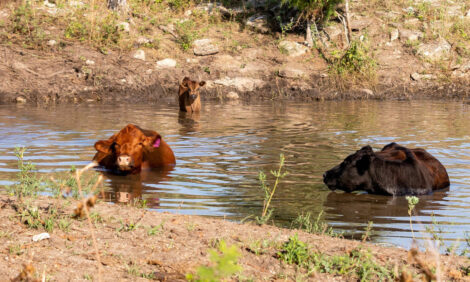



Grazing Corn Residue
Up to 14 to 16 pounds of corn (maize) residue per bushel are left on the field, which according to Rory Lewandowski, Wayne County Educator at Ohio State University is a feed opportunity.
Corn, grain, cob, husks, leaves and stalks all constitute suitable feed stuff, fed from harvest through December. The exceptions are livestock in a late gestation or lactation stage of production.
In addition to using a low cost feedstuff, grazing corn residue removes animals from grass pastures during the late fall period, adds M Lewandowski. This can benefit pastures, insuring that they are not overgrazed before they go dormant. Grazing corn residues can help to stretch stockpiled forages so that they are not used until later in the year.
The nutritional value of corn residue varies depending upon how the residue is grazed, the amount of time that has passed between harvest and grazing and environmental conditions. According to a South Dakota State University Extension publication entitled "Grazing Corn Stalks" a crude protein (CP) content of 8 per cent and a total digestible nutrient (TDN) content of 70 per cent can be expected early in the grazing period.
Over time the nutritional content will decrease to 5 per cent CP and 40 per cent TDN. This is a typical pattern where livestock are provided with an entire field or a large section of a field and allowed to graze over an extended time period of 30 to 60 days. The nutrient content decreases because livestock are selecting the highest quality, most palatable portions of the residue first and because nutrient content decreases as the residue weathers and soluble nutrients are leached out.
The University of Nebraska has done a lot of research on the topic of grazing corn residue. A University of Nebraska study conducted over a 5 year period from 2004 to 2009 measured corn grain left in the field after harvest.
An average of 1.0 bu/acre was available for livestock grazing. A 2004 Nebraska beef report on corn stalk grazing included more information about the make-up of corn residue. Generally, stalks account for 49 per cent of the residue dry matter, leaves 27 per cent , husks 12 per cent and cobs another 12 per cent of the residue dry matter.
Livestock typically consume any corn grain first. After the grain, plant leaves and husks are eaten and the last portions of residue eaten are cobs and stalks. Strip grazing across a field can even out the nutritional quality because livestock will be forced to consume both the higher and lower quality components of the residue within a given grazing period before the fence is moved to provide a new strip. A 2004 Nebraska beef report on corn stalk grazing listed the average TDN value at 54-55 per cent .
Now let's look at an example of how corn residue can be used. The general rule of thumb that is used is; one acre of corn residue will provide grazing for one mature cow for about 45 days. Often that cow is defined as one animal unit or 1000 lbs. Most cows are heavier than that so those thumb rule grazing days are less in most instances.
If corn yield is 150 bushels per acre, we might expect somewhere around 2250 lbs. of total dry matter residue. Not all of that dry matter residue will be consumed. University of Nebraska research on the effect of stocking rate on animal performance and diet quality while grazing cornstalks demonstrated that very little if any of the corn stalks are eaten. The study measured the amount of each component of corn residue consumed as a percentage of the total dry matter consumed by cattle.
After corn grain, leaves and husks accounted for 71 to 88 per cent of the total residue consumed and cobs contributed up to another 23 per cent . Overall the study found that less than one-third of the total residue material available was actually removed from the field. The University of Nebraska has a corn residue grazing calculator available on-line at:
University of Nebraska-Lincoln has a Stalk Grazing Calculator calculates the number of corn residue acres needed for a desired number of grazing days based on corn yield and cow weight. It will even provide some economic analysis depending upon figures entered into the calculator.
Livestock in mid-gestation and even into the third trimester of gestation can do well on corn residue without additional supplementation provided they are not forced to begin eating the actual corn stalks as a significant portion of the diet.
A 2012 Nebraska Beef Cattle Report included the topic of "Supplementing Gestating Beef Cows Grazing Cornstalk Residue". This was a 5 year study that evaluated the effects of protein supplementation to beef cows grazing corn residue in late gestation.
The study concluded that "supplementing cows grazing corn stalks in mid to late gestation did not improve cow reproduction or calf performance. Protein supplementation is not necessary for cows grazing cornstalks, given they begin the grazing period in adequate body condition (BCS greater than or equal to 5)."
Occasionally I hear some misgivings that livestock can no longer get the same performance from the genetically modified corn residues compared to the non-genetically modified varieties. This topic has been investigated.
The 2004 Nebraska beef report included results from a study that used steer calves grazing four different fields of corn residue for 60 days. The four fields were residue from a Bt corn rootworm variety, a non Bt variety, a Roundup Ready (RR) variety and a non RR variety.
The conclusion was steer performance was not different between Bt corn or RR hybrids and their non-genetically modified variety controls. The same study concluded that "there was also no preference between Bt and non Bt hybrids" during the grazing period.
Some crop farmers may be wary of letting a neighbor's livestock graze across a field because of concerns about possible negative impact on the yields of subsequent grain crops. This subject has also been researched at the University of Nebraska in a series of multi-year corn residue grazing studies using various stocking densities.
The conclusion as reported in the 2013 Nebraska Beef Cattle Report was that ". . . corn grain yields in either a continuous corn or a corn-soybean rotation show no effect of grazing on grain yields and soybeans planted the year following corn residue grazing show a significant increase in yields due to grazing treatment."
Corn residue represents another opportunity to extend the grazing season. Those graziers willing to find a way to use corn residues by developing relationships with crop farmers, utilizing temporary fencing and water can reduce the amount of stored forage needed for winter feeding and reduce production costs.


